This is the multi-page printable view of this section.
Click here to print.
Return to the regular view of this page.
Communication rules
Introduction
Communication rules is one category of rules to enable automated communications with process users, for example sending meeting requests or even user push notifications.
Take an example of a User alert rule. Implementing this rule will result in a new item in the user notification in the Quick action menu, for example a rule that alerts a user to complete a form. The user notification icon will look like this when the alert comes in, indicating there is one new notification: 
Clicking on the notification icon, opens up a pop-up box with the notification, for example:

Clicking on the Reminder itself will bring the user to that form within the process instance, for the user to complete.
Depending on how you configure the alert, you can create an alert message which appears as a warning in a user’s workspace as shown in the image below.
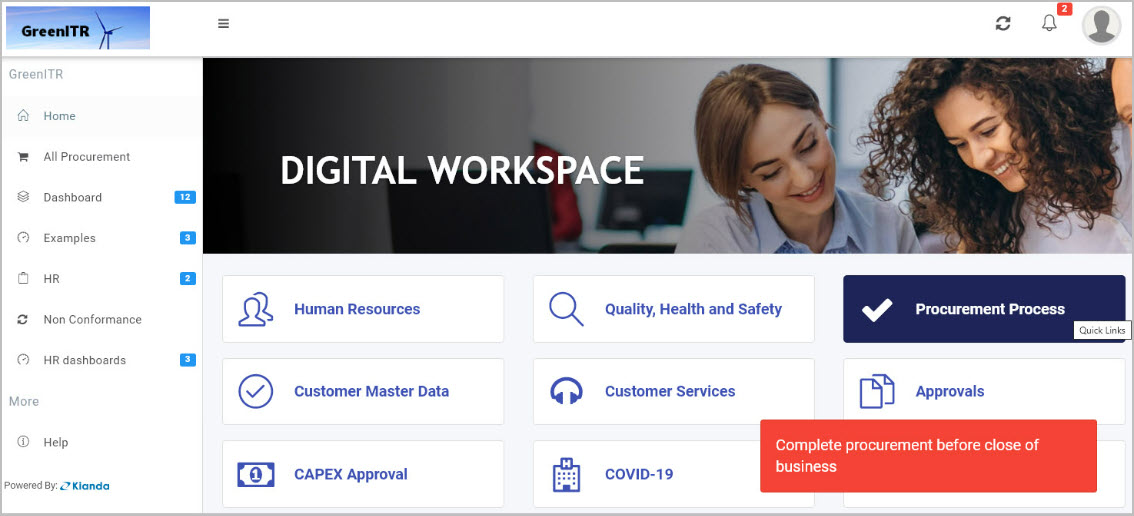
Getting started with Communication rules
If you go to Administration > Designer and click on a process or create a new process, then click on Add a rule the Communication rules are found in the left-hand pane when you click on Communications.
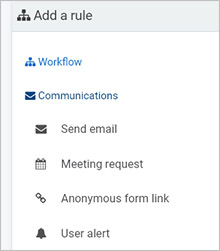
There are four types of Communication rules as follows:
-
Send email - This rule allows you to send automated emails that contain images, text, process and other links and attachments. Email templates are defined within the rule, allowing you to style emails the way you want and use Expressions to automate the process. You can map fields and content from within the process, for example using a userpicker field so that user input in a form determines who an email is sent to. Emails can be sent out using a predefined SMTP connector, see Setting up a Global SMTP mail Connector for more details.
-
Meeting request - This rule is similar to the Send email rule and allows you to send automated specially formatted emails that contain a meeting request.
-
Anonymous form link - This rule creates an anonymous link to a form which can be sent to external users who do not need Kianda login details or accounts to access the form(s), for example contractors or third party providers. The receivers of the link can then simply click on the link and submit data back to a process instance in Kianda.
-
User alert - This rule sends an alert to a user which appears in the user notifications in the top right-hand quick actions menu bar. See Quick action menu for an introduction to the shortcuts available to users including notifications. You can configure the alert to appear the way you want for example to allow warning messages to appear as shown in the image in the Introduction or to link to a form for a user to complete.
What’s next 
To read more about each of the rule types go to the links below:
1 - Send email
This rule sends an email according to a predefined template. Each element of the email is configurable. The body of the email can include text, images and attachments. Data stored in fields in the current form can be copied in dynamically.
When to use the Send email rule
You can add this rule:
Before you get started
In advance of using this rule, you need to have created one or more forms, complete with control fields. For example a text box control with an employee’s ‘Name’ may be part of a form ‘Annual Leave Request’. Then this ‘Name’ field can be used as an expression in the email to send personalised emails, so these aspects must be set up in advance.
- Decide how the rule will be implemented, for example will an email be sent once a form is saved or submitted. In the example of form submit, then click on that form in the process > Submit button > Add a rule > Send email.
- Decide who the automated email will be sent from, for example a no-reply type email. If you leave the From field empty, the email will be sent from noreply@kianda.com. If you want your email to come from a different sender, then go to Email connector for more details on how to set that up.
- Any email addresses to send To, From, CC or BCC must be set up in advance. This could be a textbox in a form called ‘Email address’ with a unique Name like ’emailAddress’, or it could be a user picker field associated with particular users, groups or partners.
- If you want to track the emails, then you must set up a field in your form to store email tracking.
- If you want to attach any files to an email, files must first be stored in a File field in one of the forms.
How to get started
-
Click on an existing process by going to Administration > Designer and decide which form, or field you will apply the rule to, by clicking on that item so that it is in edit mode so you can see the Edit/pen button, Pen button  . For example selecting the Submit as shown below.
. For example selecting the Submit as shown below.
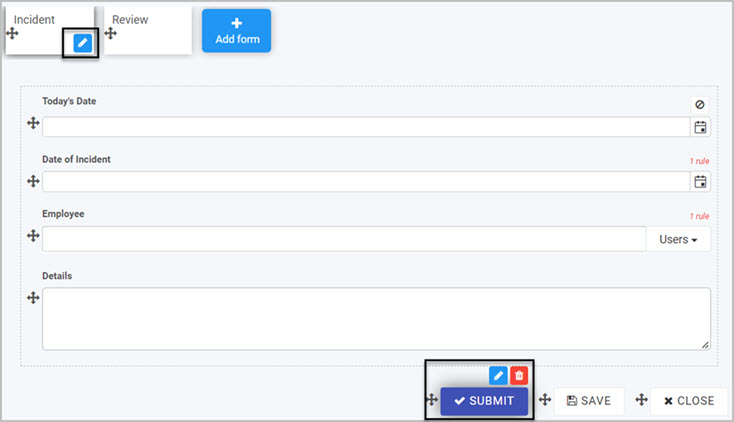
-
In the left-hand side pane, click on Add a rule > Communications > Send email.
-
Choose from the edit options:
-
Title - of the email for example ‘Send email to Training Managers’
-
Edit conditions - click on Edit conditions  to set conditions for sending an email, for example while a process has a ‘status’ of ‘open’, send reminder emails. To learn more about conditions go to Conditions.
to set conditions for sending an email, for example while a process has a ‘status’ of ‘open’, send reminder emails. To learn more about conditions go to Conditions.
-
From - who the email is from, click on Person button  and choose from the appropriate Selection mode, see Selection mode below.
and choose from the appropriate Selection mode, see Selection mode below.
Warning
If you add an email address to the From field, you must specify an Email connector, see Email connector. If a connector is not specified, the emails will come from noreply@kianda.com. If a Global SMTP connector is configured, all emails will be sent from the global connector.
-
To - who the email is to, click on Person button  and choose from the appropriate Selection mode, see Selection mode below.
and choose from the appropriate Selection mode, see Selection mode below.
-
CC - who will be copied on the email, as with To field.
-
BCC - who will be blind copied on the email, as with To field.
-
Subject - type in your email subject and click on the Ellipsis button  to add an expression, go to Expression builder for more information. The Subject cannot be left empty.
to add an expression, go to Expression builder for more information. The Subject cannot be left empty.
-
Body - choose from an array of styles and formats to create your email including Style, Colour, Font size, Remove font style, Font family, Unordered list, Ordered list, Paragraph, Table, Link, Picture, Attach a File and Code view. For example if you click on Code view button  you can copy HTML code directly into the body text.
you can copy HTML code directly into the body text.
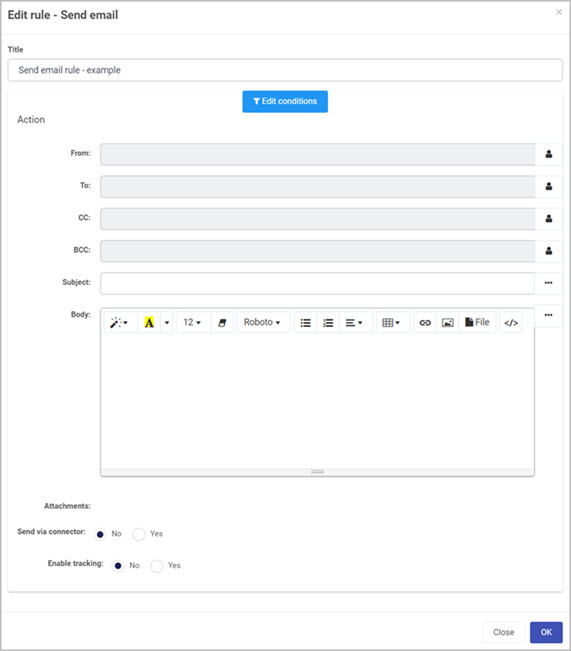
If you click on the Picture button  you will be redirected to the File storage area where you can search for existing images stored in the Kianda file system, create a folder, or upload a file.
you will be redirected to the File storage area where you can search for existing images stored in the Kianda file system, create a folder, or upload a file.
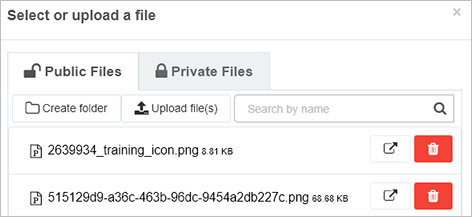
To find out more about how to attach a file, see Attachments for more details.
To add a message to your email, click on the Body text box. You can personalise automated emails using fields from the process by clicking on the Ellipsis button  to add an expression, see Expression builder for more details.
to add an expression, see Expression builder for more details.
-
Send via connector - options are a) No or b) Yes
If you choose Yes then you must choose an Email connector and decide if you want to Save Sent Items (Yes or No) which means sent emails are saved in a sent items folder in your email account. For more information go to Email connector

Note that if Global SMTP Mail connector has been configured, all emails sent will use the Global connector settings instead, including no-reply@kianda.como find out more, go to Setting up a Global SMTP mail connector.
-
Enable tracking - options are a) No or b) Yes
-
Note that this option is only available if Send via connector is set to No and the email is being sent from noreply@kianda.com.
-
If you choose Yes then you must click into the field under Field to store tracking event (Open, Click, Bounce, Spam) and choose a field from a form to store the event.

- This option allows you to track the email after it is sent. All of these events, Open, Click, Bounce and Spam will be tracked.
-
Click on OK button when you are finished editing to save your changes or click on Close to exit the dialog box without saving.
-
Note when your rule is complete you may want to change the order of rules for the particular field or form that it has been applied to. Drag the new Send email rule to where you want, so the order of execution of rules is correct.
For example for a Submit button on a form I may want my Send email rule to be executed first before any other rule is executed. To do this click on the Submit button to make sure you are in Edit mode, and under Rules in the right-hand pane, drag the Send email rule to the top of the list by clicking on the rule and dragging it.
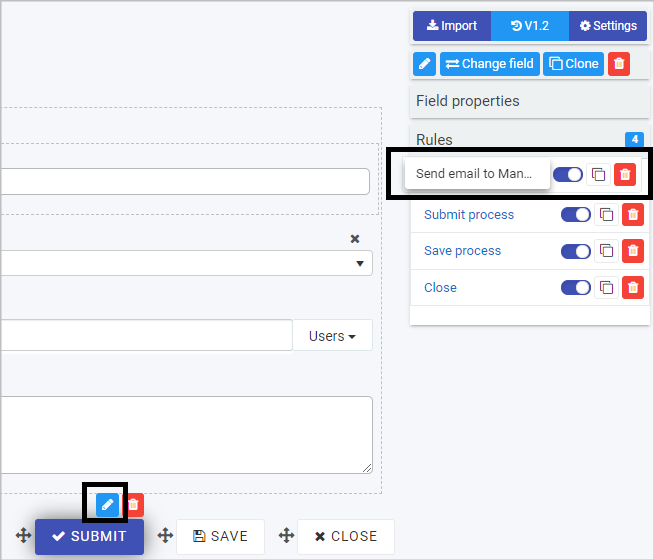
For more information on rule order, see Multiple Rules.
Email connector
The Email connector is a mailing tool that allows you to send emails with a specified email account, for example support@ or info@. An email connector must be set up in advance, to learn how to set up an Email connector go to Email connector.
If you leave the From field empty, the email will be sent from noreply@kianda.com. If you want your email to come from a different sender, follow these steps when you are editing the Send email rule:
- Set Send via connector to Yes.
- Click into the field under Email connector and select a connector.
- Click on OK button when you are finished editing to save your changes or click on Close to exit the dialog box without saving.
Note that if Global SMTP Mail connector has been configured, all emails sent will use the Global connector settings instead of what is specified in the send email rule. Go to Administration > Subscription > Subscription Details to check for a global setting or to find out more, go to Setting up a Global SMTP mail connector.
Selection mode
When you are filling out the To, From, CC or BCC fields and click on the Person button  you have the following selection mode options to choose from:
you have the following selection mode options to choose from:
Note; You can reset user/ field you selected by clicking Clear on the dropdown field in the Select email users dialog box.
on the dropdown field in the Select email users dialog box.
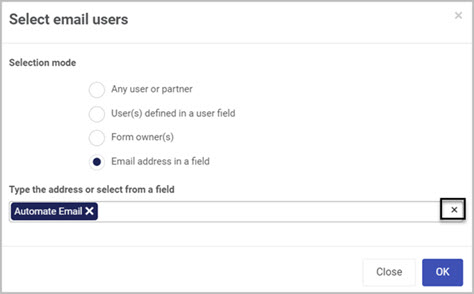
-
Any user or partner - With this Selection mode selected. On the right-hand side of the Select users dropdown list, you can choose to select from Users, Groups and Partners. This allows you to distinguish which users are picked for this field. For example a single user, or a group of users.
-
User(s) defined in a user field - if you choose this option, it means the user name is already defined in a form. By clicking into the Select a user field, you can select a field from the process you are working in.
-
Click on the desired User field in your process to add to the Select a user field box.

-
Click on  to add more selection fields.
to add more selection fields.

-
Remove a field clicking on the Bin/Trash button

-
Form owner(s) - With this option selected, by clicking into the field under Form owner of selected form and choose from the forms within that process. This automatically uses the form owner(s) email address. To learn more about forms and form owners go to Form basics.
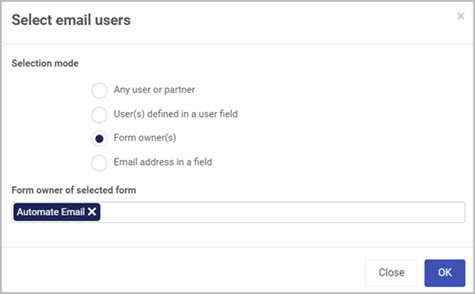
-
Email address in a field - With this option selected, by clicking into the field under Type the address or select from a field, you can either type in an email address or choose from a field within the process you are working in.
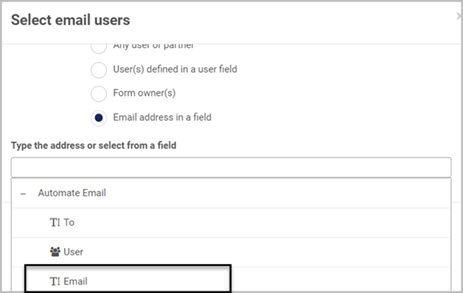
In all cases when you have made your selection, click on OK button to save your changes or click on Close to exit the dialog box without saving.
Expression builder
The expression builder is a useful and efficient way to use existing form fields as part of automated emails that you want to send out.
For example if you have a form Annual Leave request that contains a text box field ‘Employee Name’ you can use this field in an automated email to let a manager know that an employee has submitted a request.
-
Before you begin have your message inserted into the Body of the email and position your cursor where you want to add an expression, for example an Employee Name after ‘Your employee’ as shown below.

-
Click on the Ellipsis button  on the right-hand side of the email Body. An Expression builder dialog box opens.
on the right-hand side of the email Body. An Expression builder dialog box opens.
-
Click into the field under Add field to expression. Forms and fields that are part of your process appear where you can expand elements to drill down to find the field that you want, for example ‘Employee Name’. Click on the field to add field to the expression.
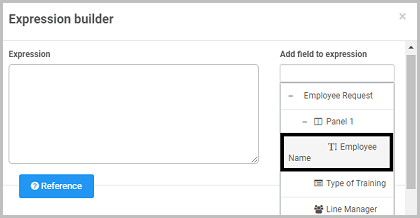
-
Click on the Add to expression button  to add the field as an expression. Note that the expression is the Name(unique) of that field.
to add the field as an expression. Note that the expression is the Name(unique) of that field.

-
Click on OK button when you are finished editing to save your changes or click on Close to exit the dialog box without saving.
-
The result is the expression is now part of the automated email.

-
To add more expressions, firstly position your cursor in your body text where you want to add the expression, then click on the Ellipsis button and under Add field to expression clear any existing fields by clicking on the Clear button. This appears when you hover over the Add field box.

Then search for other fields, for example lists or links, and use the Expression reference functions, see step 7.
-
Click on Reference  to find out how to use particular functions in your email. For example ProcessLink() returns the html link to the current process. Copy this function into the Expression box and click on OK to add the function. Then in the Body type in the text you want associated with this link for example “click here” into the brackets of the function:
to find out how to use particular functions in your email. For example ProcessLink() returns the html link to the current process. Copy this function into the Expression box and click on OK to add the function. Then in the Body type in the text you want associated with this link for example “click here” into the brackets of the function:

In this way you can build personalised automated emails that provide a link back to a process instance, for example that a manager can view, update or approve. For more information on References and Expressions see Expressions for more information.
Attachments
To attach a file into the Send email rule, you must first contain a file field in your process. To learn more about file control go to File upload control.
-
To attach a file to an email, click on the Attach a file button  . The Attach file to email dialog box opens.
. The Attach file to email dialog box opens.
-
Select a File field from your process to attach the file, for example an Image filed as shown in the image below.
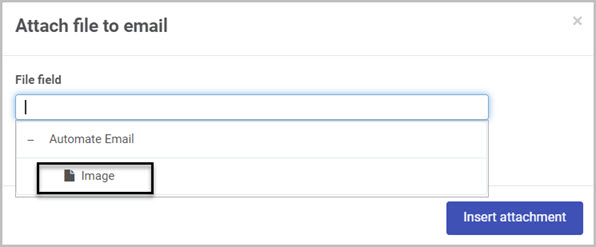
-
Click in the File field, find and select the desired field.
-
Click on Insert attachment. There is an option to attach a link to the file rather than the file itself.
In the Attachments section of the Send email dialog box, the name of the File field will appear indicating that attachments will come from the specified field. You can delete the specified File field by clicking the red bin/trash icon.
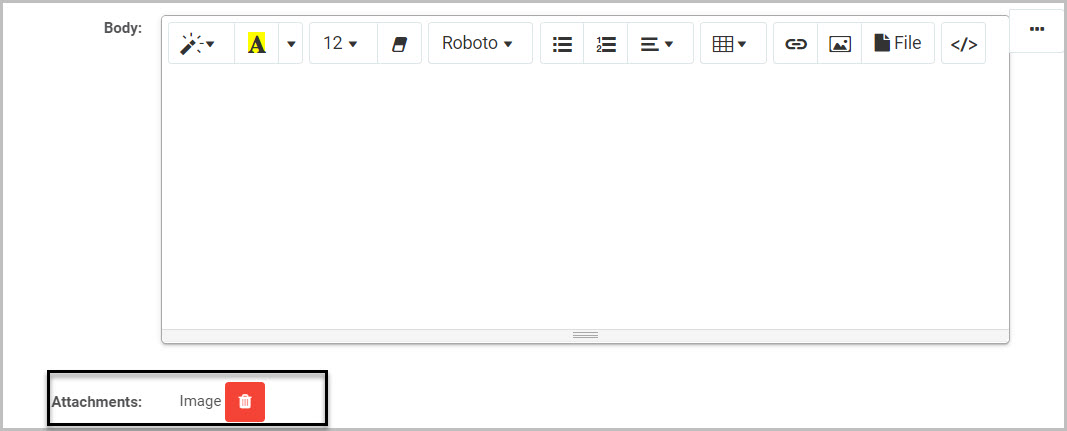
What’s next 
To find out more about other communication rules go to Communication rules.
To find out more about other rules go to Rules.
2 - Meeting request
The Meeting request rule sends an email according to a predefined template. It works exactly like the Send email rule with three additional fields to which are used to set up the date and time of the meeting. The three additional fields are as follow:
-
Start time - indicating the starting date and time of the meeting.
-
End time - indicating the ending date and time of the meeting.
-
Location - indicating the location of the meeting.

If you are using an email connector, a meeting request will appear in the calendar of the receiver(s). Otherwise the meeting request will appear as a calendar file (.ics file type) attached to an email. to learn more about email connector go to Email connector.
When to use
You can add this rule:
Before you get started
In advance of using this rule, you need to have created one or more forms, complete with control fields. For example a Text box control with an employee’s ‘Name’ may be part of a form ‘Meeting request’. Then this ‘Name’ field can be used as an expression in the email to send personalised emails, so these aspects must be set up in advance. The Meeting request rule must also contain three specific fields which are the Date control for both the Start and End time fields, as well as textbox control or a List control a field for the Location.
- Decide how the rule will be implemented, for example will an email be sent once a form is saved or submitted. In the example of form submit, then click on that form in the process > Submit button > Add a rule > Send email.
- Decide who the automated email will be sent from, for example a no-reply type email. If you leave the From field empty, the email will be sent from noreply@kianda.com. If you want your email to come from a different sender, then go to Email connector for more details on how to set that up.
- Any email addresses to send To, From, CC or BCC must be set up in advance. This could be a textbox in a form called ‘Email address’ with a unique Name like ’emailAddress’, or it could be a user picker field associated with particular users, groups or partners.
- If you want to track the emails, then you must set up a field in your form to store email tracking.
- If you want to attach any files to an email, files must first be stored in a File field in one of the forms.
Note; the start and end time fields are both required on the request meeting rule therefore you should make the start and end fields required on your form too. To learn more about required fields go to Control properties.
How to get started
-
Click on an existing process by going to Administration > Designer and decide which form, or field you will apply the rule to, by clicking on that item so that it is in edit mode so you can see the Edit/pen button  . For example selecting the Submit as shown below.
. For example selecting the Submit as shown below.

-
In the left-hand side pane, click on Add a rule > Communications > Meeting request rule.
-
In the Edit rule - Meeting request dialog box, fill out the following details:
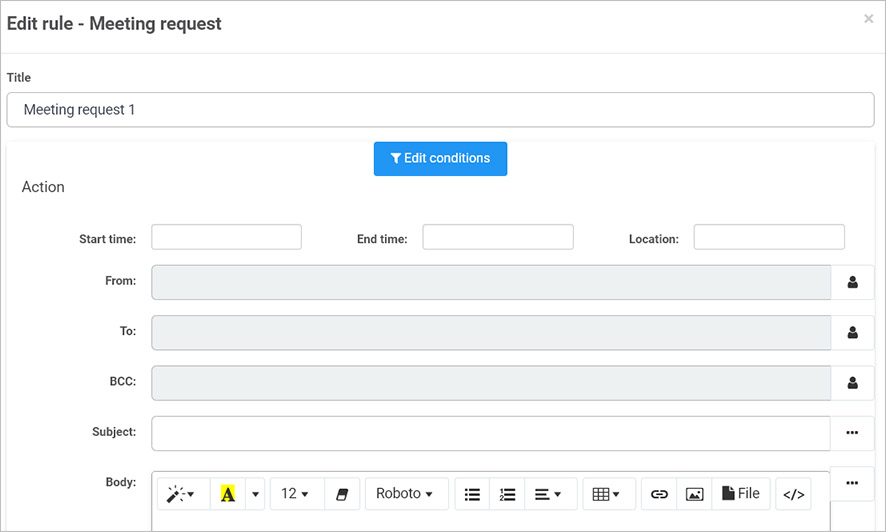
- Title - of the email for example ‘Send meeting request’
- Edit conditions - click on Edit conditions
 to set conditions for sending an email, for example while a process has a ‘status’ of ‘open’, send reminder emails. To learn more about conditions go to Conditions.
to set conditions for sending an email, for example while a process has a ‘status’ of ‘open’, send reminder emails. To learn more about conditions go to Conditions. - Start time - select a pre-defined date field from your form. This is a required field.
- End time - select a pre-defined date field from your form. This is a required field.
- From - who the email is from, click on Person button
 and choose from the appropriate Selection mode, see Selection mode below.
and choose from the appropriate Selection mode, see Selection mode below.
Warning
If you add an email address to the From field, you must specify an Email connector, see Email connector. If a connector is not specified, the emails will come from noreply@kianda.com. If a Global SMTP connector is configured, all emails will be sent from the global connector.
- To - who the email is to, click on Person button
 and choose from the appropriate Selection mode, see Selection mode below. This is a **required **field.
and choose from the appropriate Selection mode, see Selection mode below. This is a **required **field. - BCC - who will be blind copied on the email, as with To field.
- Subject - type in your email subject and click on the Ellipsis button
 to add an expression, go to Expression builder for more information. This is a **required **field.
to add an expression, go to Expression builder for more information. This is a **required **field. - Body - choose from an array of styles and formats to create your email including Style, Colour, Font size, Remove font style, Font family, Unordered list, Ordered list, Paragraph, Table, Link, Picture, Attach a File and Code view. For example if you click on Code view button
 you can copy HTML code directly into the body text. This is a required field.
you can copy HTML code directly into the body text. This is a required field.

To find out more about how to attach a file, see Attachments for more details.
To add a message to your email, click on the Body text box. You can personalise automated emails using fields from the process by clicking on the Ellipsis button  to add an expression, see Expression builder for more details.
to add an expression, see Expression builder for more details.
-
Click on OK button when you are finished editing to save your changes or click on Close to exit the dialog box without saving.
-
Note when your rule is complete you may want to change the order of rules for the particular field or form that it has been applied to. Drag the new Meeting request rule to where you want, so the order of execution of rules is correct.
For example for a Submit button on a form I may want my Meeting request rule to be executed first before any other rule is executed. To do this click on the Submit button to make sure you are in Edit mode so that the Edit/pen button  appears, and under Rules in the right-hand pane, drag the Meeting request rule to the top of the list by clicking on the rule and dragging it. For more information on rules, see Rules.
appears, and under Rules in the right-hand pane, drag the Meeting request rule to the top of the list by clicking on the rule and dragging it. For more information on rules, see Rules.
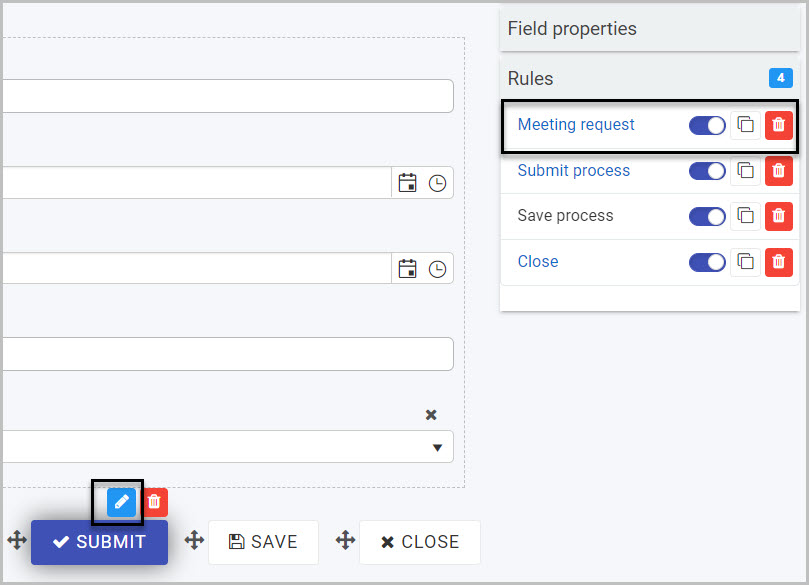
Email connector
The Email connector is a mailing tool that allows you to send emails with a specified email account, for example support@ or info@. An email connector must be set up in advance, to learn how to do that go to Email connector.
If you leave the From field empty, the email will be sent from noreply@kianda.com. If you want your email to come from a different sender, follow these steps when you are editing the Meeting request rule:
- Set Send via connector to Yes.
- Click into the field under Email connector and select a connector.
- Click on OK button when you are finished editing to save your changes or click on Close to exit the dialog box without saving.
Note that if Global SMTP Mail connector has been configured, all emails sent will use the Global connector settings instead of what is specified in the send email rule. Go to Administration > Subscription > Subscription Details to check for a global setting or to find out more, go to Setting up a Global SMTP mail connector.
Selection mode
When you are filling out the To, From, or BCC fields and click on the Person button  you have the following selection mode options to choose from:
you have the following selection mode options to choose from:
Note; You can reset user/ field you selected by clicking Clear on the dropdown field in the Select email users dialog box.
on the dropdown field in the Select email users dialog box.

-
Any user or partner - choose from Users, Groups and/or Partners in the drop-down list. All users must be predefined in the system, see Users and Groups for more details.
-
User(s) defined in a user field - choose a user picker field from the process, where the selected users, groups or partners will be assigned to the To, From or BCC respectively.
-
Click on the desired User field in your process to add to the Select a user field box.

-
Click on  to add more selection fields.
to add more selection fields.

-
Remove a field clicking on the Bin/Trash button

-
Form owner(s) - selecting this option allows you to click into the field under Form owner of selected form and choose from the forms within that process. This automatically uses the form owner(s) email address. To learn more about forms and form owners go to Form basics.

- Email address in a field - With this option selected, by clicking into the field under Type the address or select from a field, you can either type in an email address manually or choose from a field within the process you are working in.

In all cases when you have made your selection, click on OK button to save your changes or click on Close to exit the dialog box without saving.
Expression builder
The expression builder is a useful and efficient way to use existing form fields as part of automated emails that you want to send out.
For example if you have a form Annual Leave request that contains a text box field ‘Employee Name’ you can use this field in an automated email to let a manager know that an employee has submitted a request.
-
Before you begin have your message inserted into the Body of the email and position your cursor where you want to add an expression, for example an Employee Name after ‘Your employee’ as shown below.

-
Click on the Ellipsis button  on the right-hand side of the email Body. An Expression builder dialog box opens.
on the right-hand side of the email Body. An Expression builder dialog box opens.
-
Click into the field under Add field to expression. Forms and fields that are part of your process appear where you can expand elements to drill down to find the field that you want, for example ‘Employee Name’. Click on the field to add field to the expression.

-
Click on the Add to expression button  to add the field as an expression. Note that the expression is the Name(unique) of that field.
to add the field as an expression. Note that the expression is the Name(unique) of that field.

-
Click on OK button when you are finished editing to save your changes or click on Close to exit the dialog box without saving.
-
The result is the expression is now part of the automated email.

-
To add more expressions, firstly position your cursor in your body text where you want to add the expression, then click on the Ellipsis button and under Add field to expression clear any existing fields by clicking on the Clear button. This appears when you hover over the Add field box.

Then search for other fields, for example lists or links, and use the Expression reference functions, see step 7.
-
Click on Reference  to find out how to use particular functions in your email. For example ProcessLink() returns the html link to the current process. Copy this function into the Expression box and click on OK to add the function. Then in the Body type in the text you want associated with this link for example “click here” into the brackets of the function:
to find out how to use particular functions in your email. For example ProcessLink() returns the html link to the current process. Copy this function into the Expression box and click on OK to add the function. Then in the Body type in the text you want associated with this link for example “click here” into the brackets of the function:

In this way you can build personalised automated emails that provide a link back to a process instance, for example that a manager can view, update or approve. For more information on References and Expressions see Expressions for more information.
Attachments
To attach a file into the Send email rule, you must first contain a file field in your process. To learn more about file control go to File upload control.
-
To attach a file to an email, click on the Attach a file button  . The Attach file to email dialog box opens.
. The Attach file to email dialog box opens.
-
Select a File field from your process to attach the file, for example an Image filed as shown in the image below.

-
Click in the File field, find and select the desired field.
-
Click on Insert attachment. There is an option to attach a link to the file rather than the file itself.
In the Attachments section of the Send email dialog box, the name of the File field will appear indicating that attachments will come from the specified field. You can delete the specified File field by clicking the red bin/trash icon.

What’s next 
To find out more about other communication rules go to Communication rules.
To find out more about other rules go to Rules.
3 - Anonymous form link
The Anonymous form rule creates a link to a selected form from the process which can be sent to an external user. The user can open the form without the need for authentication into the Kianda platform.
When to use
To use the Anonymous form rule effectively, you would typically apply it to a Submit button along side Send email rule so that you can attach the link into an email and share the specified form with an external user.
You can add this rule:
Before you get started
In advance of using the Anonymous form link, in your process you need to have created at least one or more forms. This rule also requires a link to be stored inside of a field, for example text box control. To learn more about text box control go to Text box control.
How to get started
To send an anonymous form link to an external user:
-
Click on an existing process by going to Administration > Designer and decide which form, or field you will apply the rule to, by clicking on that item so that it is in edit mode so you can see the Edit/pen button, Pen button  .
.
-
Click on Add a rule > Communications > Anonymous form link.
-
In the Edit rule - Anonymous form link dialog box, give the rule a title in the Title field.
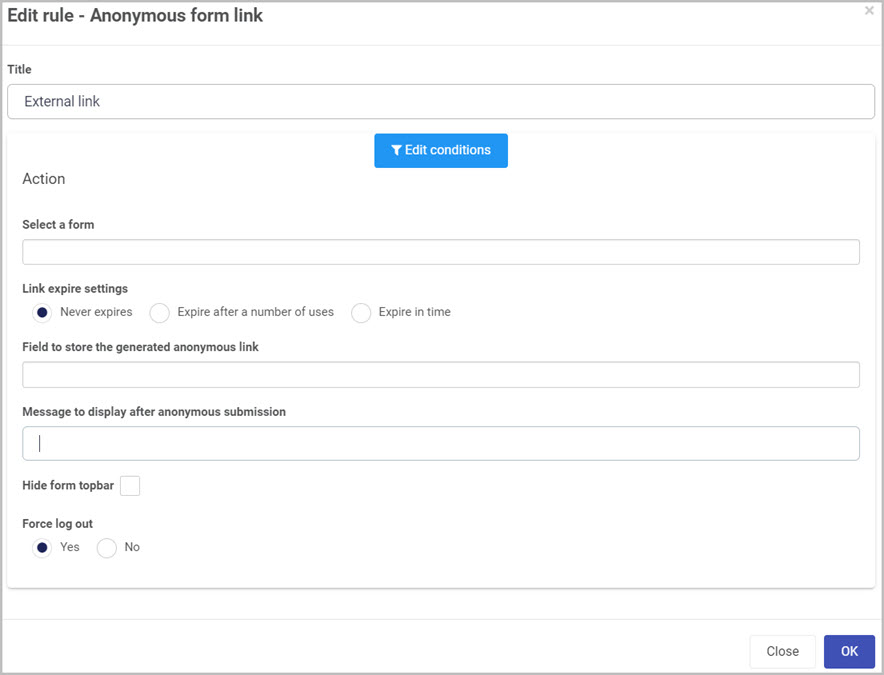
-
If you want to add conditions for the rule, click on the Edit conditions button  to create conditions for the rule, see Conditions for more details.
to create conditions for the rule, see Conditions for more details.
-
In the Select a form dropdown, select the desired form to create a link to.
-
Link expire settings contains three options:
-
Never expires - Indicating that the link will never expire and will always be active.
-
Expire after a number of uses - the link will expire after the specified number of uses in the Expire link after number of uses text box.

-
Expire in time - the link will expire after the specified Days, Hours and Minutes from the time it was created.

-
In the Field to store the generated anonymous link dropdown, select a field in which you want the link to be stored in.
-
In the Message to display after anonymous submission text box, type in a message your want users to see after they submit the form.


-
Selecting the Hide form topbar will hide all form tiles from the users view.
-
Force logout:
- Yes - users will be logged out after submitting the form.
- No - users will stay logged in after submitting the form.
-
Create a Send email rule and apply the link expression to the body of the email. To learn more about Send email rule and how to add expressions go to Send email.
User tip 
- The field used to store the Anonymous Link can be made invisible to the user of the current form. Go to the field properties and set the field to not visible.
- Each record or instance of a process can have only one active link. If a second anonymous link is created for an instance of a process, the first link will not exist anymore. Users clicking on the first link will get an error message.
What’s next 
To find out more about other communication rules go to Communication rules.
To find out more about other rules go to Rules.
4 - User alert
The User alert rule sends an alert to a user who can click on the alert to open the process instance, for example to a form that needs to be completed by a given user. A user can view all alerts by clicking on the notifications or bell icon on the top right-hand corner of their screen.
For example in the image below there is one new notification.

When the user clicks on the icon, the alert created using the User alert rule appears.

In this example clicking on the alert itself, will bring the user to a form that they need to fill out.
When to use
There are a lot of uses for the user alert rule. For example, the rule can be used as a reminder to complete a form or when a form is submitted and the form needs to be reviewed, a manger can receive the alert to review the information in the form.
You can add this rule:
How to get started
-
Click on an existing process by going to Administration > Designer and decide which form, or field you will apply the rule to, by clicking on that item so that it is in edit mode so you can see the Edit/pen button, Pen button  .
.
-
Click on Add a rule > Communications > Anonymous form link.
-
In the Edit rule - User alert dialog box, give the rule a title in the Title field.

-
If you want to add conditions for the rule, click on the Edit conditions button  to create conditions for the rule, see Conditions for more details.
to create conditions for the rule, see Conditions for more details.
-
Send alert to - choose from the radio buttons:
- Any user - choose from Users, Groups and/or Partners in the drop-down list. All users must be predefined in the system, see Users and Groups for more details.
- Current user - make the current user of the form, whoever is submitting or saving information, as the person that the alert is being sent to.
- Defined in a user field - choose a user picker field from the process, where the selected users, groups or partners will have an alert sent to.
- Form owner(s) - selecting this option means that the form owner(s) defined during form creation/editing will have the alert sent to, see Form owners for more details on what form ownership is and how to create form owners.
-
Alert title - select a field from the process to be the title or type one in.
-
Alert message - select a field from the process for the message of the alert or type one in. Note: Maximum of 200 characters allowed in message.
-
Alert Status - choose from four different colours to be applied to the tile of the alert.
-
Alert icon - choose an icon from the drop-down list.

The resulting alert design looks like this:

-
Process ID - when the user receives an alert and clicks on it, he will open the process instance defined in the Process ID field.
-
If left blank, this field will contain the current Process ID.
-
A different process ID can be added by typing or copying in the ID (or if the Process ID is stored in a field, then that field can be selected).
What’s next 
To find out more about other communication rules go to Communication rules.
To find out more about other rules go to Rules.






 to set conditions for sending an email, for example while a process has a ‘status’ of ‘open’, send reminder emails. To learn more about conditions go to
to set conditions for sending an email, for example while a process has a ‘status’ of ‘open’, send reminder emails. To learn more about conditions go to  and choose from the appropriate Selection mode, see
and choose from the appropriate Selection mode, see  to add an expression, go to
to add an expression, go to  you can copy HTML code directly into the body text.
you can copy HTML code directly into the body text.
 you will be redirected to the File storage area where you can search for existing images stored in the Kianda file system, create a folder, or upload a file.
you will be redirected to the File storage area where you can search for existing images stored in the Kianda file system, create a folder, or upload a file.


 on the dropdown field in the Select email users dialog box.
on the dropdown field in the Select email users dialog box.

 to add more selection fields.
to add more selection fields.





 to add the field as an expression. Note that the expression is the Name(unique) of that field.
to add the field as an expression. Note that the expression is the Name(unique) of that field.


 to find out how to use particular functions in your email. For example ProcessLink() returns the html link to the current process. Copy this function into the Expression box and click on OK to add the function. Then in the Body type in the text you want associated with this link for example “click here” into the brackets of the function:
to find out how to use particular functions in your email. For example ProcessLink() returns the html link to the current process. Copy this function into the Expression box and click on OK to add the function. Then in the Body type in the text you want associated with this link for example “click here” into the brackets of the function:
 . The Attach file to email dialog box opens.
. The Attach file to email dialog box opens.






 to create conditions for the rule, see
to create conditions for the rule, see 







